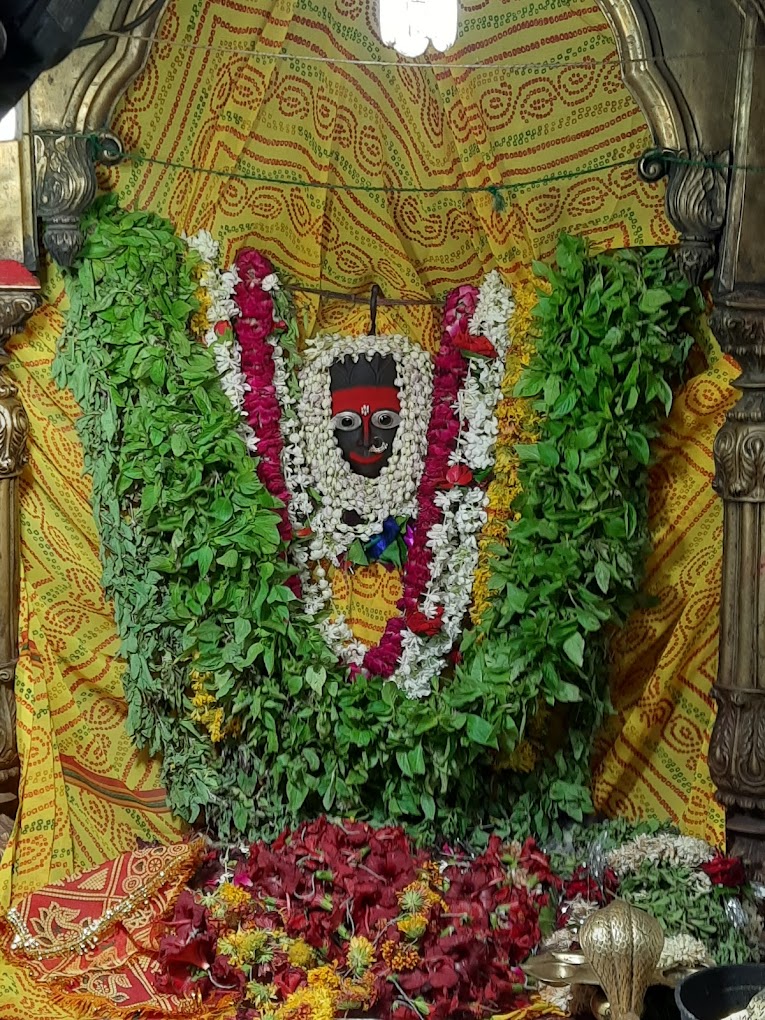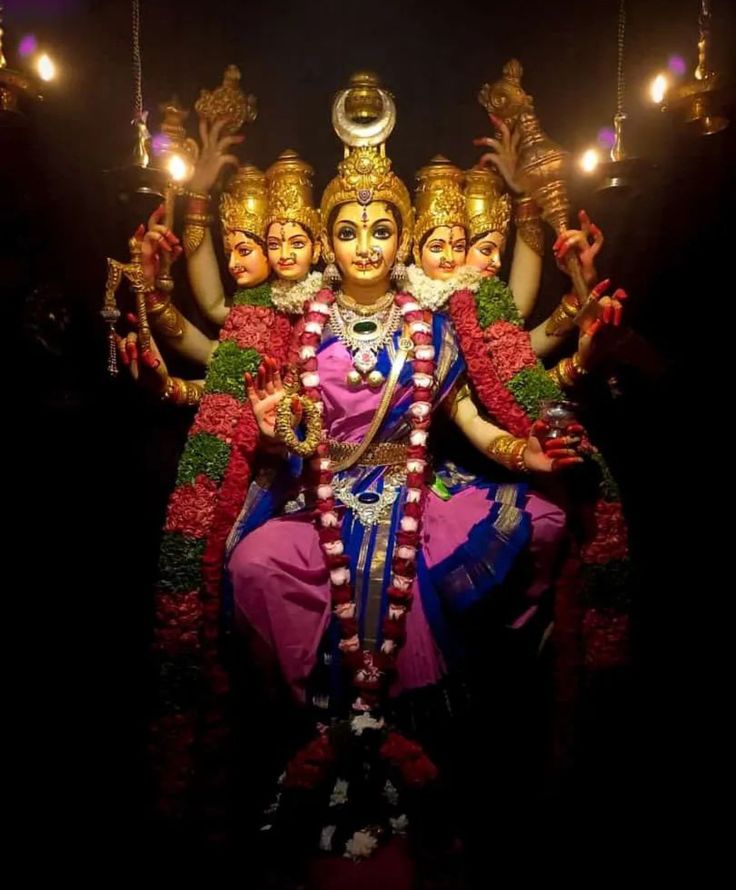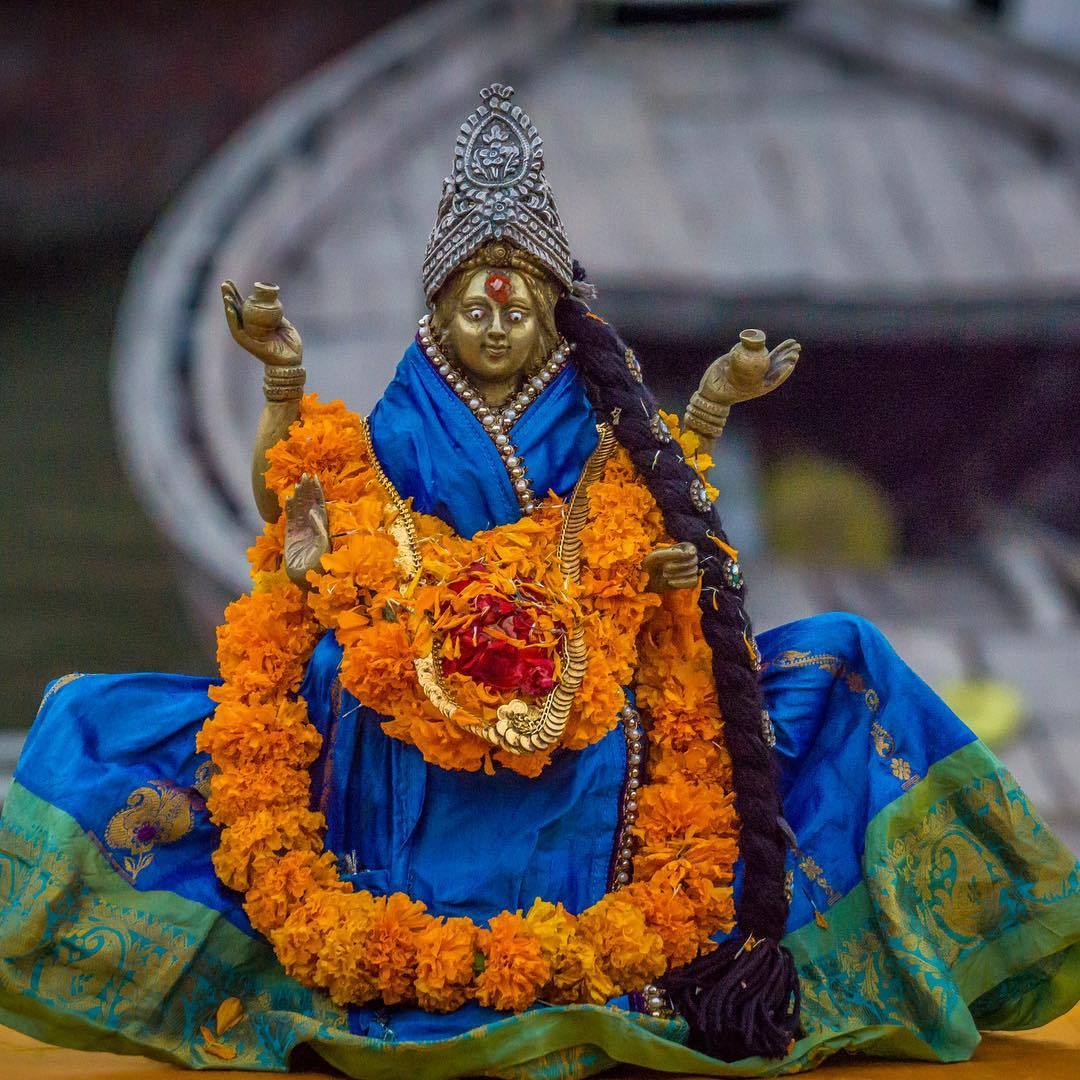Dhumavati Jayanti marks the appearance of Goddess Dhumavati, the seventh of the ten Mahavidyas, celebrated on Jyeṣṭha Śukla Aṣṭamī. She is one of the most misunderstood yet powerful forms of Shakti. Associated with void, smoke, detachment, and ultimate knowledge, her worship holds deep tantric, spiritual, and philosophical meaning.
Who is Goddess Dhumavati?
Goddess Dhumavati is the seventh Mahavidya among the Dasha Mahavidyas. She is considered the embodiment of inauspiciousness, detachment, and spiritual transcendence. She is associated with widowhood, sadness, loss, and the void. Despite her fierce and unattractive appearance, she grants wisdom, protection, and liberation to her devotees. Dhumavati is a representation of the cosmic void that exists before creation and after dissolution.
She is depicted as an old, widowed goddess, dressed in tattered white or smoke-colored garments, with unkempt hair, missing teeth, and a thin, pale body. She rides a horseless chariot or a crow and holds a winnowing basket, symbolizing the ability to separate truth from illusion.
Dhumavati is more than a widow goddess. In some traditions, she is also a sumangali (auspicious married woman) in forms like Mahadhuma and Ganga Haimavati. The Dhumavati Sahasranama includes names such as Parvatipatipriya and Shuddha, suggesting her association with Shiva in auspicious aspects.
She is also known as Vriddhamata, the grandmother spirit, and Dhumavati Balaambika, the protector of mothers and children. She is said to reside in delivery rooms and bless childbirth.
Other forms include Kakachandesvari and Kakarudha Dhumavati. Her presence is also seen through real-life challenges—illness, poverty, death, and societal conflict—as manifestations of her transformative energy.
Origins and Scriptural Background
Dhumavati appears in Hindu scriptures including the Pranatoshini Tantra and other tantric texts. There are multiple legends associated with her origin:
- In one version, when Sati immolated herself in Daksha’s yajna, the smoke from her body gave rise to Dhumavati.
- In another version, Parvati, overcome with hunger, swallowed Shiva. After being requested to release him, she did so, but Shiva cursed her to live as a widow. This resulted in her manifestation as Dhumavati.
- A third version links her appearance to the Samudra Manthan, where she emerged in contrast to Lakshmi, symbolizing the forces of poverty and misfortune.
These legends reflect her association with loss, sacrifice, and transformation.
Puja Vidhi & Katha (Step-by-Step)
Dhumavati Jayanti is observed with rituals that are primarily performed by tantriks, ascetics, widows, bachelors, and spiritual seekers. Married women are generally advised not to worship her directly due to her association with widowhood and detachment.
-
Sankalpa: take a vow to remove ignorance and conquer inner poverty.
-
Invoke the Void: meditate on a flickering ghee lamp until its smoke curls upward; visualise the universe dissolving.
-
Yantra abhisheka: sprinkle the yantra with black sesame water, then wipe dry—teaching that clarity emerges after obscurity.
-
Stotra recitation: recite Dhumavati Kavach and the Sahasranama, alternating with the myth of her smoky birth, reinforcing the lesson of transcendence through loss.
-
Homa: offer camphor, dry neem leaves, and a strand of white cotton to a small fire, symbolising consumed attachments.
-
Prasad: distribute roasted gram or simple rice gruel-foods favoured by renunciates-to underline non-attachment.
Rituals involve waking up early, taking a bath, and sitting for puja in silence. Offerings include black sesame seeds, mustard seeds, white or black clothing, and dry flowers. The mantra “ॐ धूं धूं धूमावती देव्यै स्वाहा॥” is chanted 108 times.
The worship is conducted with a yantra or an image of the goddess. Devotees maintain celibacy, avoid non-vegetarian food, and stay silent during the day. Some also perform fire offerings (homa) and recite her sahasranama.
Her worship is also observed during Gupt Navratri and the Chaturmasya period.
Spiritual and Astrological Significance
Dhumavati is associated with the shadow planet Ketu. Ketu represents detachment, liberation, and karmic lessons. Worship of Dhumavati is recommended for mitigating the negative effects of Ketu in one’s horoscope. It is particularly beneficial for those facing chronic obstacles, depression, health issues, and spiritual stagnation.
She is also linked to tamas guna, representing inertia, ignorance, and dissolution. However, her worship is aimed at transcending these qualities. She is regarded as the force behind yogic sleep (Yoganidra) and the stillness before cosmic creation.
Celebrations Across India
Dhumavati temples are rare. The most notable temple is located in Varanasi, where she is worshipped both by tantric practitioners and local devotees. In this temple, she holds a broom, pot, and winnowing basket and offers protection to devotees.
-
Varanasi (Uttar Pradesh): A rare standalone shrine near Lohatia where local families seek her protective aspect, integrating liquor-free offerings with folk songs.
-
Pitambara Peeth, Datia (Madhya Pradesh): Gupt Navratri nights draw sadhakas for “kakakarma” rituals invoking her crow symbolism.
-
Nilachal, Assam: Within the Kamakhya complex, ascetics mark the tithi with silent meditation in forest clearings.
Offerings may include meat, liquor, and other items in tantric rituals. However, standard puja items like flowers, incense, and fruits are also accepted.
Yantra Worship and Sadhana Practices
The Dhumavati Yantra is used for worship to invoke the goddess’s protection and blessings. It is known to:
- Help overcome sorrow, diseases, and depression.
- Neutralize the malefic effects of Ketu.
- Provide spiritual upliftment, siddhi (supernatural abilities), and moksha (liberation).
- Align energy through activation of the root chakra.
Tantric sadhana of Dhumavati is performed in secluded areas like cremation grounds. Special days include Krishna Paksha Chaturthi (fourth day of the dark fortnight). Advanced practitioners may perform the Kakakarma (crow ritual) for destructive purposes, though this is restricted to initiated tantriks.
Philosophical Importance
Dhumavati represents the rejection of superficial appearance and the pursuit of inner truth. Her ugly form is meant to break attachment to beauty and illusion. The winnowing basket symbolizes the discernment needed to separate reality from falsehood.
She embodies the power of suffering, solitude, and renunciation. Worship of Dhumavati is meant to bring patience, endurance, spiritual growth, and clarity.
Although she represents tamas, her ultimate purpose is sattva-purity and wisdom. By confronting negativity directly, devotees are guided toward transformation and liberation.
Dhumavati Jayanti is not a festival of celebration but of introspection. It is a day to understand the deeper aspects of life-sorrow, detachment, and death-and find strength and wisdom in them. Goddess Dhumavati teaches that spiritual evolution often begins with disillusionment. Her worship is for those ready to go beyond the surface and seek ultimate truth.
By observing Dhumavati Jayanti, devotees connect with the divine force that governs the end of cycles, the silence after chaos, and the wisdom that emerges from experience.




